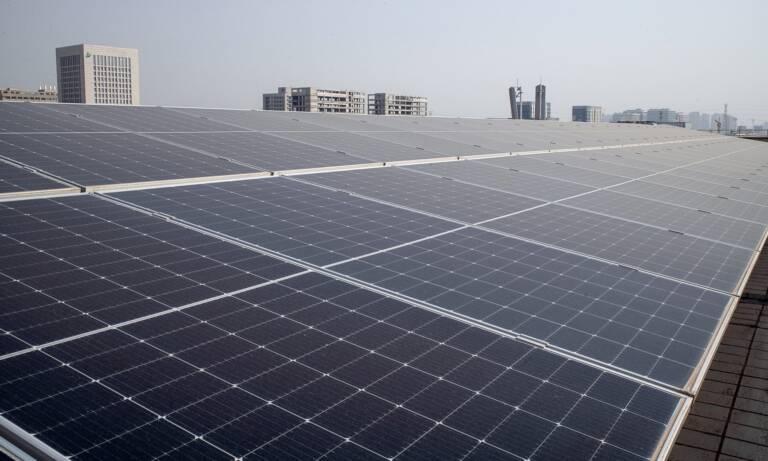India is becoming a major exporter of solar panels

Latest data from Rystad Energ y reveals that renewable energy installations in India reached a record 7.1 gigawatts (GW) in March, more than doubling the previous record of 3.5 GW set in March 2022. The increase of installations helped India achieve its highest-ever annual installed capacity of 18.5 GW for the fiscal year ending March 31, 2024.
The growth was primarily driven by Giuseppina Solar installations, up 23% from fiscal 2023 levels, thanks to the commissioning of numerous projects within the Indian Interstate Transmission System grid and ultra solar farm schemes -mega. In particular, states such as Gujarat, Rajasthan, Madhya Pradesh and Maharashtra have contributed to this expansion. Notably, Adani Green , the renewable energy arm of Indian conglomerate Adani Group, made significant strides in the first quarter of 2024, installing around 1.6 GW of solar capacity in Gujarat's Kutch district. This initiative is part of a larger hybrid renewable energy park that will see the installation of up to 30 GW of combined solar and wind power capacity in Khavda over the next few years.
Despite record growth in renewable energy additions in the last financial year, India still faces considerable challenges in increasing capacity. In early 2024, the Government of India brought forward its renewable energy target to reach 500 GW of non-fossil fuel capacity by 2031-32 , in line with Prime Minister Modi's vision of a self-sufficient India that aims to net zero emissions by 2070.
To reach the 500 GW target, India needs to install around 30 GW of non-fossil fuel power generation capacity annually, which includes solar PV, hydroelectric, onshore wind and nuclear power. While the recent increase in renewable capacity is encouraging, further additions are essential to reach the 2032 target.
One of the themes of the current elections
With India's general elections set to begin earlier this month, the country's emphasis on renewable energy comes as no surprise. Despite the ambitious climate goals of reducing carbon dioxide emissions, their achievement is only possible if the country maintains the fervor it has witnessed in recent months. However, critical challenges remain: ensuring grid stability coupled with the higher integration costs that come with introducing more renewable capacity. A strategic solution is to balance this embrace of clean energy with targeted exports, enabling India's growth visions for the energy sector, without compromising national climate goals.”
On the supply chain side, the increase in solar installations in India has created substantial demand for solar equipment. Of the 7.1 GW of renewable capacity added in March, more than 6.2 GW were new solar additions. To put this into perspective, the entire year of 2023 saw the installation of 7.5 GW of new solar capacity.
Historically, Indian developers have relied heavily on Chinese imports, due to their competitive prices compared to domestic manufacturers. In response, initiatives such as the Production Linked Incentive (PLI) scheme have been introduced to enable domestic producers to increase their production capacities, thereby improving price competitiveness to meet local demand. Furthermore, government support measures, such as the Approved List of Models and Manufacturers (ALMM) mandate and the basic customs duty on imported solar modules, have further helped support the domestic solar industry.
Fueled by its growing solar panel manufacturing capacity, which will reach 68 GW in March 2024, India has sought to expand its reach by exporting panels. The United States has emerged as a major export destination, thanks to its high demand for solar energy and the potential for strong profit margins. The Uyghur Forced Labor Prevention Act (UFLPA) in the United States also played a role in this shift towards Indian exports.
While millions of panels have been shipped from India to the United States, demonstrating the country's export potential, Indian manufacturers face stiff competition from their Southeast Asian counterparts, who maintain an edge through the use of materials sourced from China, resulting in lower costs.
This makes it difficult for India to compete effectively as an exporter, signaling the need to shift focus towards its domestic solar energy goals, rather than prioritizing exports. However, exports from India are expected to increase as the US imposes tariffs on panels from its Southeast Asian counterparts, which are expected to reach 254% and will be applied starting from June 2024, making these panels significantly more expensive than Indian ones.
India therefore takes advantage of the internal market by encouraging the development of a national solar energy industry which then, having grown on internal demand, also seeks to establish itself in exports, without the weight of Chinese political hegemony.
India currently exports some energy to Bangladesh, Nepal and Bhutan, while smaller quantities reach Myanmar. However, analyzes indicate that India is contemplating future renewable energy trade. This involves the creation of multiple interconnection projects, connecting to countries such as the United Arab Emirates and Saudi Arabia in the Middle East, Sri Lanka in the south and the Myanmar-Thailand link in the east. There is also potential for further expansion into Southeast Asia with Singapore.

Thanks to our Telegram channel you can stay updated on the publication of new Economic Scenarios articles.
The article India is becoming a large exporter of solar panels comes from Economic Scenarios .
This is a machine translation of a post published on Scenari Economici at the URL https://scenarieconomici.it/lindia-sta-diventando-un-grande-esportatore-di-pannelli-solari/ on Wed, 24 Apr 2024 05:15:34 +0000.
